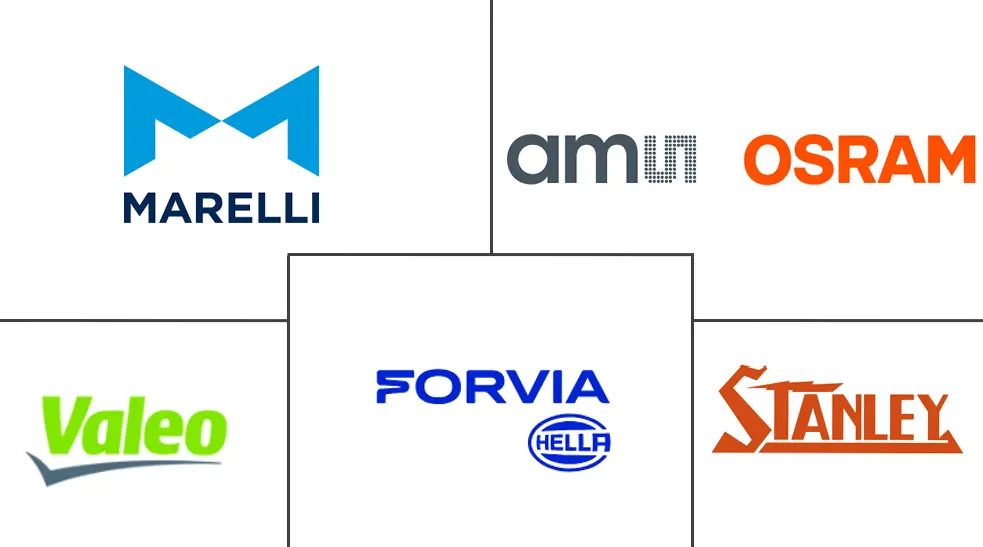Japan Automotive LED Lighting Market Size and Share
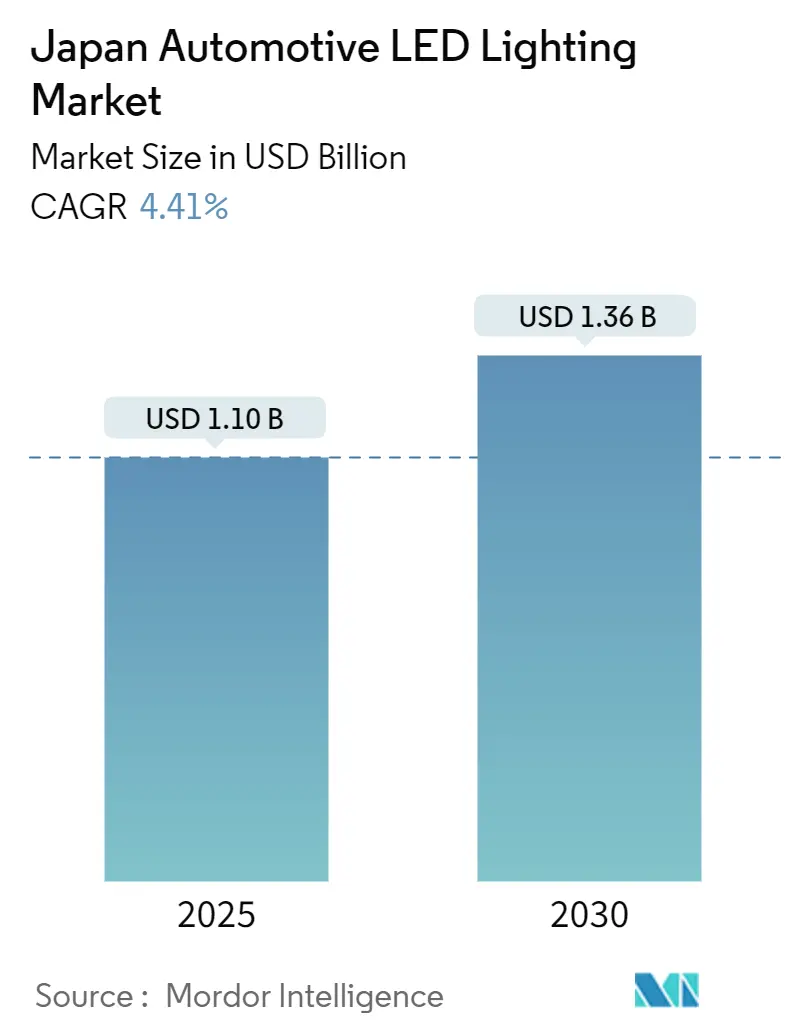
Japan Automotive LED Lighting Market Analysis by Mordor Intelligence
Japan automotive LED lighting market size was USD 1.1 billion in 2025 and is forecasted to reach USD 1.36 billion in 2030, translating into a 4.41% CAGR over the period. Steady electrification mandates, shortening LED cost curves, and stringent efficiency rules effective as of 2026 keep the growth trajectory intact as automakers integrate low-power, software-updatable lighting into next-generation battery-electric vehicle (BEV) platforms. Domestic champions Koito Manufacturing, Stanley Electric, and Ichikoh Industries reinforce a technology flywheel by funneling research and development (R&D) into adaptive driving beams (ADB), high-resolution headlamps, and sensor-lighting fusion, which in turn enables Japanese original-equipment manufacturers (OEMs) to maintain global leadership in exterior safety features. Supply-chain pressures triggered by gallium export restrictions from China have prompted manufacturers to adopt multi-regional sourcing strategies. However, ongoing Mobility DX subsidies partially offset the margin squeeze, ensuring that most model launches in 2026-2027 will feature full-LED systems as standard. Widespread 48V and zone-based electrical architectures are also streamlining wiring looms, reducing weight, and freeing energy budgets for new infotainment and autonomous driving workloads.
Key Report Takeaways
- By sales channel, the OEM segment controlled 85.13% of the Japan automotive LED lighting market share in 2024, while the aftermarket recorded the highest growth rate at 5.72% CAGR through 2030.
- By vehicle type, passenger cars held 67.43% of the Japan automotive LED lighting market size in 2024 and are advancing at an 8.66% CAGR to 2030.
- By installation type, new installations led with 63.35% share in 2024, whereas retrofit installations are expanding at 5.85% CAGR through 2030.
- By application, exterior lighting captured 77.53% share in 2024, while interior lighting is projected to grow at a 5.33% CAGR to 2030.
Japan Automotive LED Lighting Market Trends and Insights
Drivers Impact Analysis
| Driver | (~) % Impact on CAGR Forecast | Geographic Relevance | Impact Timeline |
|---|---|---|---|
| Surging OEM demand for adaptive LED headlamps | +1.2% | National, concentrated in premium vehicle segments | Medium term (2-4 years) |
| Rapid LED cost decline and efficiency gains | +0.8% | National, with spillover to aftermarket channels | Short term (≤ 2 years) |
| Japan's 2026-onward GHG/efficiency norms boosting LED penetration | +1.0% | National, affecting all vehicle categories | Medium term (2-4 years) |
| Integration of LEDs with ADAS sensor housings | +0.9% | National, early adoption in urban prefectures | Medium term (2-4 years) |
| Connected-car styling customisation trend | +0.6% | National, premium segment leadership | Long term (≥ 4 years) |
| Growth of EV platforms needing low-power lighting | +1.1% | National, accelerating in metropolitan areas | Long term (≥ 4 years) |
| Source: Mordor Intelligence | |||
Surging OEM demand for adaptive LED headlamps
Koito’s BladeScan MEMS-based ADB elevates nighttime visibility by 40% relative to static LEDs and will scale to 16,000-pixel versions for 2025 model years, transforming lamps into predictive safety systems that cooperate with vehicle-to-vehicle messages. Toyota’s rollout across premium trims underscores how ADB is shifting from luxury to baseline safety equipment, guaranteeing deep pull-through for suppliers that can refine optical algorithms, reduce power draw, and meet Japanese photometric standards. [1]Ministry of Land, Infrastructure, Transport and Tourism, “Road Transport Vehicle Safety Standards,” mlit.go.jp
Rapid LED cost decline and efficiency gains
Single-sided aluminum substrates and chip-on-board (COB) packaging have cut thermal resistance and slashed module bill-of-materials by more than 30%, making LEDs cost-competitive with halogen even in kei-car classes. Active-matrix driver ICs operating at 48 V trim wiring bulk and boost reliability, while research funded by the IEEE Electronics Packaging Society shows next-gen thermal interface materials sustaining lumen output over 10,000 h duty cycles. [2]IEEE Electronics Packaging Society, “Advanced Thermal Interface Materials for Electronics Packaging,” ectc.net
Japan’s 2026-onward GHG/efficiency norms boosting LED penetration
Fleet-average targets of 25.4 km/L by 2030, evaluated under WLTP, penalize electrical accessories; switching from halogen to LED trims 60-80% of lighting load, a statistically significant lever in corporate average fuel economy computations. Because the rules migrate from tank-to-wheel to well-to-wheel accounting for BEVs, every watt saved in lighting directly extends electric range and improves compliance headroom.
Integration of LEDs with ADAS sensor housings
Stanley Electric’s venture with Mitsubishi Electric merges lighting, cameras, and LiDAR into thermally unified modules, lowering drag coefficients and smoothing assembly line calibration routines. Mobility DX grants earmark semiconductor-photonics R&D, incentivizing suppliers to commercialize dual-function light-sensor arrays that tackle glare control and object detection simultaneously. [3] Ministry of Economy, Trade and Industry, “Mobility DX Strategy,” meti.go.jp
Restraints Impact Analysis
| Restraint | (~) % Impact on CAGR Forecast | Geographic Relevance | Impact Timeline |
|---|---|---|---|
| Slower two-wheeler LED uptake outside urban prefectures | -0.4% | Rural and suburban prefectures | Medium term (2-4 years) |
| Dependence on imported high-power LED chips | -0.6% | National, affecting all manufacturers | Short term (≤ 2 years) |
| Aftermarket price wars squeezing margins | -0.3% | National, concentrated in retrofit segment | Short term (≤ 2 years) |
| Rising rare-earth material costs for phosphors | -0.5% | National, upstream supply chain impact | Medium term (2-4 years) |
| Source: Mordor Intelligence | |||
Slower two-wheeler LED uptake outside urban prefectures
Rural riders prize repairability over sophistication, and fragmented dealer networks rarely stock LED retrofit kits certified under Japan’s photometric test regimen, muting penetration until distribution and training widen.
Dependence on imported high-power LED chips
China’s gallium curbs raised spot prices 20-30%, prompting Koito and Stanley to diversify sourcing through Taiwan and U.S. epitaxy vendors while lobbying for domestic fab incentives. The qualification cycle for automotive-grade dies, however, exceeds 18 months, creating near-term volatility.
Segment Analysis
By Sales Channel: OEM Integration Drives Technology Leadership
The OEM segment accounted for 85.13% of Japan automotive LED lighting market share in 2024, a dominance rooted in the deep vertical collaboration typical of Japan’s keiretsu arrangements. Factory-fitted systems marry adaptive luminaires with ADAS domain controllers, making field retrofits impractical and cementing OEM volume. In value terms, the Japan automotive LED lighting market size for OEM installations hit USD 0.93 billion in 2025. OEM preference for calibrated, in-line programming sustains demand even as chip prices fall, because automakers treat lighting as core to vehicle safety ratings.
Aftermarket avenues rise at 5.72% CAGR as owners modernize halogen fleets; yet the segment stays constrained by regulatory photometry checks that require certified workshops and by limited rural dealer density. Online channels grow briskly, but professional installation packages from PIAA and Car Mate dominate revenue because vehicle inspection compliance demands beam-pattern validation equipment unavailable to do-it-yourself enthusiasts.
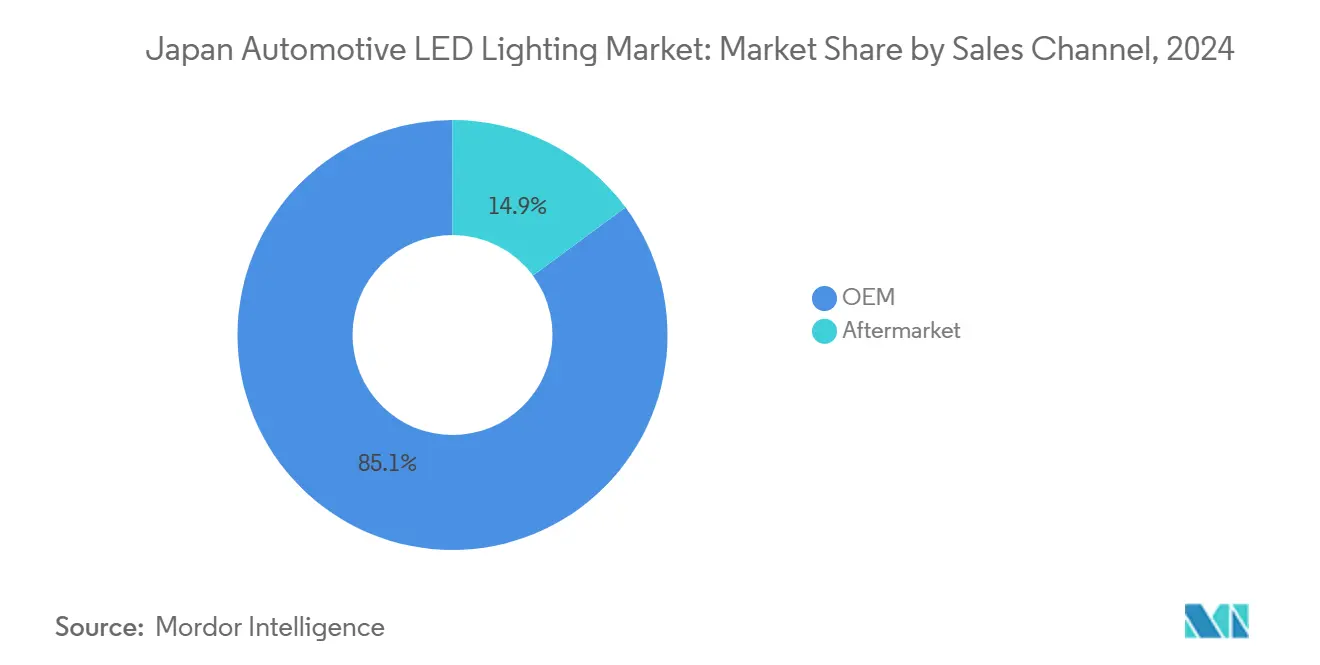
By Vehicle Type: Passenger Cars Pioneer Advanced Technologies
Passenger cars contributed 67.43% of Japan automotive LED lighting market size in 2025, reflecting the class’s role as a proving ground for BladeScan, micro-LED taillamps, and welcome-light scripts. The segment’s 8.66% CAGR outpaces all others as BEV rollouts multiply LED points per vehicle. Crossovers such as the 2025 RAV4 embed matrix headlamps and animated turn signals, spurring tier-one suppliers to accelerate pixel counts and low-glare algorithms.
Commercial vans and light trucks adopt LEDs primarily for durability; ROI stems from longer service intervals rather than branding. Heavy trucks migrate to LED clusters that integrate fog, DRL, and cornering functions, reducing harness weight by up to 3 kg per cab. Two-wheeler adoption remains bipolar, thriving in dense prefectures where scooter sharing schemes favor energy savings yet stalling in agricultural regions sensitive to upfront premiums.
By Installation Type: Retrofit Market Gains Traction
New-vehicle installations still commanded 63.35% of Japan automotive LED lighting market share in 2024 as every major domestic assembly line switched to full-LED exterior arrays. Continued platform churn keeps volumes robust because 2026-onward models must satisfy stricter glare and efficiency norms that older halogen tooling cannot achieve economically.
Retrofit demand expands 5.85% CAGR through 2030, aided by Japan’s aging fleet age of 13.6 years. Certified kits bundle driver ICs pre-tuned for legacy alternator ripple, ensuring pass-through at mandatory inspections. Interior ambient retrofit kits featuring Bluetooth control and multi-color modes gain favor among urban youth, while rural owners prioritize higher-lumen headlamp swaps for night farming and coastal routes.
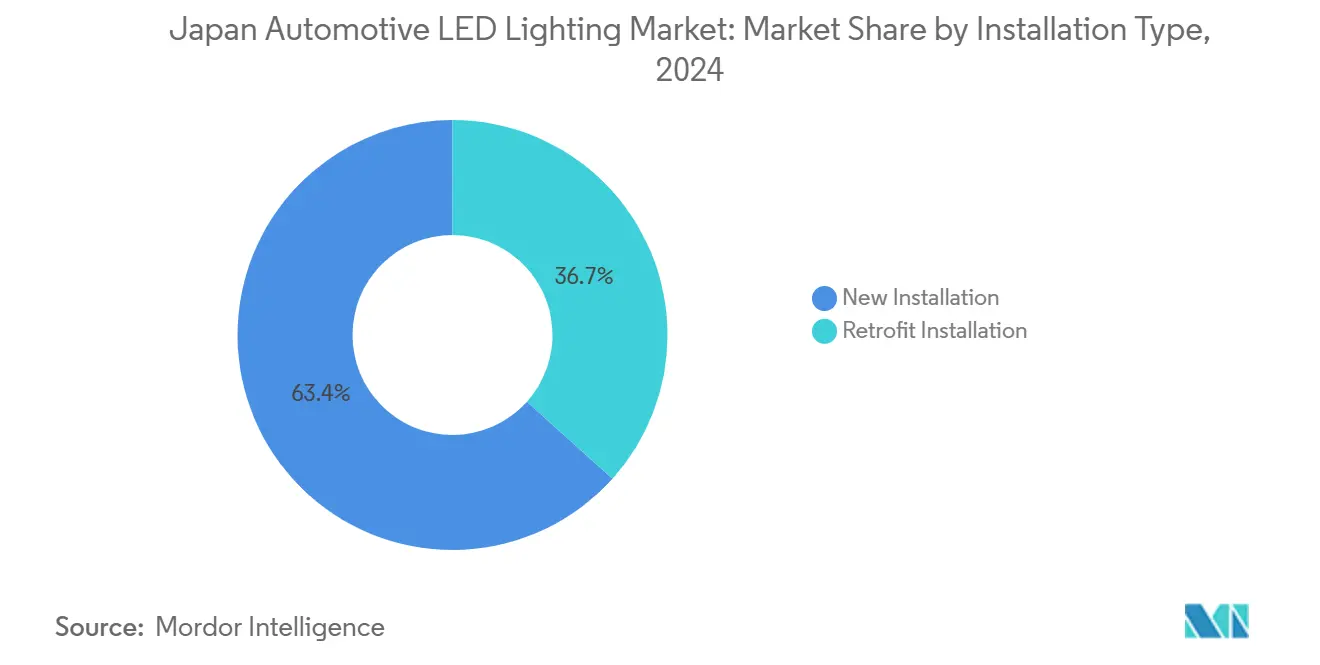
By Application: Exterior Dominance with Interior Innovation
Exterior lighting captured 77.53% of Japan automotive LED lighting market size in 2024. Headlamps alone comprised roughly half of that value as ADB and pixelized modules drove bill-of-material increases. Taillights followed, leveraging OLED-on-TFT carriers from Marelli to deliver brand-signature animations visible at 150 m, all within 10 mm assembly depths.
Interior lighting rises 5.33% CAGR as automakers monetize cabin ambience. Zone ECUs coordinate foot-well, door, and dash strips with climate presets and navigation triggers, offering subscription up-sell paths. Battery-electric SUVs tie ambient hues to state-of-charge, turning color bands into intuitive range indicators and reinforcing ecosystem branding.
Geography Analysis
Remaining Segments in Automotive Vehicle Lighting
Manufacturing clusters around the Tokai corridor, anchoring a tight loop between Toyota’s Motomachi complex and Koito’s Fujioka lamp plant. Close physical proximity allows joint prototype sprints measured in days rather than weeks, conferring a speed advantage that global rivals struggle to match. Urban prefectures, such as Tokyo, Osaka, and Nagoya, lead the uptake of matrix headlamps and customizable DRLs, as premium trim mixes account for over 40% of registrations, whereas rural regions tend to skew toward baseline LEDs.
Hokkaido and Tohoku provide stress-test grounds for thermal cycling and snowpack reflectivity; suppliers tweak phosphor blends to counteract blue-shift under -20 °C ambient conditions. Ministry-sponsored pilot routes in Sapporo test LiDAR-in-lamp assemblies under heavy snowfall to validate sensor-fusion robustness for autonomous shuttles.
Logistics flows funnel rare-earth imports through Tokyo Bay and Osaka Bay ports before transferring them by rail to LED packaging houses in Kanagawa and Aichi. Just-in-time buffers hover at 14 days, down from 21 days prior to 2024, illustrating supply-chain tightening following gallium price spikes. Regional economic revitalization programs now subsidize warehouse automation in Kyushu to spread risk away from the seismically active Pacific Belt.
Competitive Landscape
The Japan automotive LED lighting market clusters around three incumbents-Koito Manufacturing, Stanley Electric, Ichikoh Industries, whose combined 2024 revenue share exceeded 68%. Long-standing equity cross-holdings, such as Toyota’s 20.9% stake in Koito, deepen codevelopment intimacy and block easy entry by overseas tier-ones. Competition has shifted toward software: pixel-level dimming algorithms, over-the-air upgrades, and cybersecurity hardened light controllers are the new differentiators.
Koito plans 16,000-pixel HD lamps that integrate traffic-sign projection by 2026, locking in premium contracts at Lexus and Subaru. Stanley Electric’s tie-up with Mitsubishi Electric couples radar signal paths to adaptive beam cutoff, enabling real-time glare suppression. Ichikoh leverages parent Valeo’s global supply chain to source 1.3 µm LiDAR emitters, offering bundled sensor-lighting modules aimed at Level 3 autonomy rollouts on Nissan’s Skyline sedan.
Patent race intensity is high: Japan Patent Office filings for automotive solid-state lighting exceeded 1,400 in 2024, up 9% year over year. University consortia in Osaka experiment with gallium-free nitride alloys, potentially relieving geopolitical material risks; early prototypes deliver 165 lm/W efficacy at automotive currents, hinting at another cost-down wave post-2028.
Japan Automotive LED Lighting Industry Leaders
Stanley Electric Co., Ltd.
HELLA GmbH & Co. KGaA
ams-OSRAM AG
Magneti Marelli CK Holdings Co., Ltd.
Valeo S.A.
- *Disclaimer: Major Players sorted in no particular order
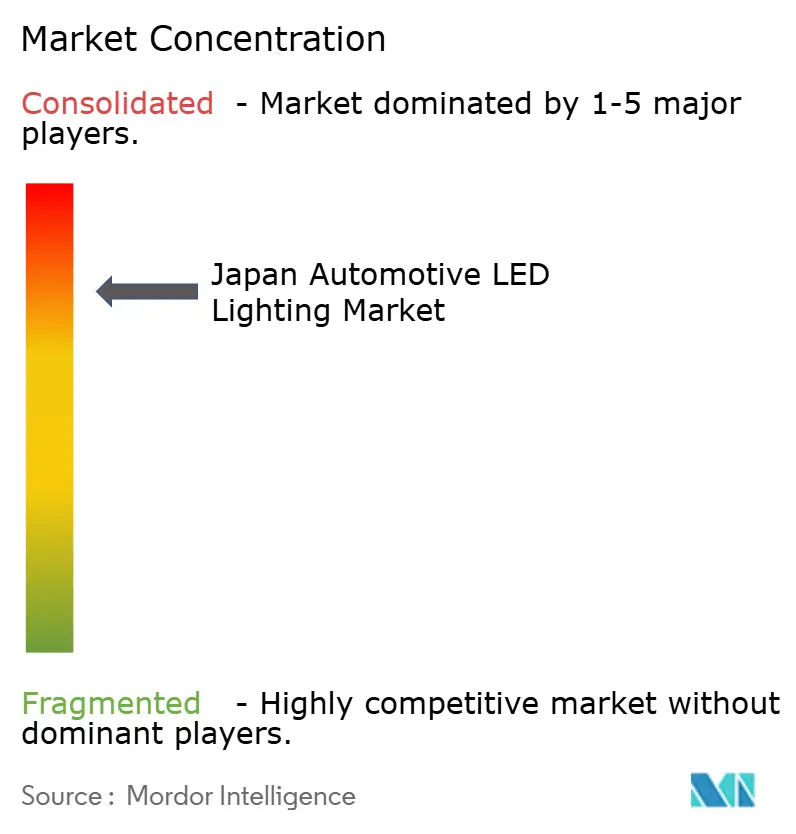
Recent Industry Developments
- March 2025: Stanley Electric and Mitsubishi Electric formed a joint venture to co-develop next-generation vehicle lighting and sensor fusion platforms.
- February 2025: Toyota published its 2024 integrated report, outlining BEV targets of 1.5 million units by 2026 and 3.5 million by 2030, elevating LED demand for low-power exterior systems.
- January 2025: Toyota Motor Corporation launched the new RAV4 in Japan with software-defined capabilities spanning CORE, ADVENTURE, and GR SPORT trims, all featuring factory adaptive LED arrays.
- December 2024: The Society of Automotive Engineers of Japan announced 2025 congress sessions covering LED glare regulations and certification pathways.
Japan Automotive LED Lighting Market Report Scope
Daytime Running Lights (DRL), Directional Signal Lights, Headlights, Reverse Light, Stop Light, Tail Light, Others are covered as segments by Automotive Utility Lighting. 2 Wheelers, Commercial Vehicles, Passenger Cars are covered as segments by Automotive Vehicle Lighting.| OEM |
| Aftermarket |
| Passenger Cars |
| Light Commercial Vehicles |
| Heavy Commercial Vehicles |
| Two-Wheelers |
| New Installation |
| Retrofit Installation |
| Exterior Lighting | Headlamps |
| Daytime Running Lights | |
| Taillights | |
| Fog Lamps | |
| Turn Signals | |
| Other Exterior Lightings | |
| Interior Lighting | Dome and Map Lights |
| Ambient Lighting | |
| Instrument Cluster and Infotainment Backlighting | |
| Others Interior Lightings |
| By Sales Channel | OEM | |
| Aftermarket | ||
| By Vehicle Type | Passenger Cars | |
| Light Commercial Vehicles | ||
| Heavy Commercial Vehicles | ||
| Two-Wheelers | ||
| By Installation Type | New Installation | |
| Retrofit Installation | ||
| By Application | Exterior Lighting | Headlamps |
| Daytime Running Lights | ||
| Taillights | ||
| Fog Lamps | ||
| Turn Signals | ||
| Other Exterior Lightings | ||
| Interior Lighting | Dome and Map Lights | |
| Ambient Lighting | ||
| Instrument Cluster and Infotainment Backlighting | ||
| Others Interior Lightings | ||
Market Definition
- INDOOR LIGHTING - It incorporates all LED based lamps and fixtures/luminaire that are used to illuminate indoor section of residential, commercial, industrial buildings and agricultural lighting. LED offers efficient brightness with higher durability in comparison to other lighting technology.
- OUTDOOR LIGHTING - It incorporates the LED lighting fixtures that is used for illumination for exterior/outdoor illumination. For instance, LED lighting fixtures used to illuminate streets and highways, transport hubs, stadiums and other public places such as parking spaces.
- AUTOMOTIVE LIGHTING - It refers to the lighting fixtures installed for illumination and signaling purposes. It is used in both exterior and interior lighting of the vehicle. Headlamps, fog lamp, daytime running light (DRLs) are examples of exterior light whereas cabin light are interior lights.
- END USER - It refers to the end use application area where the LED fixture will be installed. For instance, in terms of indoor lighting, we have residential, commercial and industrial as end user category. For automotive lighting, primary end user considered are automotive manufacturers and aftermarket sale
| Keyword | Definition |
|---|---|
| Lumen | Lumen is a unit of luminous flux in the International System of Units that is equal to the amount of light given out through a solid angle by a source of one-candela intensity radiating equally in all directions. |
| Footcandle | A foot-candle (or foot-candle, fc, lm/ft2, or ft-c) is a measurement of light intensity. One foot-candle is defined as enough light to saturate a one-foot square with one lumen of light. |
| Colour Rendering Index (CRI) | Color Rendering Index (CRI) is a measurement of how natural colors render under an artificial white light source when compared with sunlight. The index is measured from 0-100, with a perfect 100 indicating that colors of objects under the light source appear the same as they would under natural sunlight. |
| Luminous flux | Luminous flux is a measure of the power of visible light produced by a light source or light fitting. It is measured in lumens (lm). |
| Annual Energy Cost | Annual Energy Cost means the average daily energy consumption multiplied by 365 (days per year), expressed in kilowatt hour per year (kWh/a). |
| Constant voltage drivers | Constant voltage drivers are designed for a single direct current (DC) output voltage. Most common constant voltage drivers (or Power Supplies) are 12VDC or 24VDC. An LED light that is rated for constant voltage usually specifies the amount of input voltage it needs to operate correctly. |
| Constant Current Driver | Constant current LED drivers are designed for a designated range of output voltages and a fixed output current (mA). LEDs that are rated to operate on a constant current driver require a designated supply of current usually specified in milliamps (mA) or amps (A). These drivers vary the voltage along an electronic circuit which allows current to remain constant throughout the LED system. |
| Minimum Energy Performance Standards (MEPS) | Minimum Energy Performance Standards specify the minimum level of energy performance that appliances and equipment must meet or exceed before they can supply or used for commercial purposes. |
| Luminous Efficacy | Luminous efficacy is a measurement commonly used in the lighting industry that indicates the ability of a light source to emit visible light using a given amount of power. |
| Solid State Lighting | Solid-state lighting (SSL) is a type of lighting that uses semiconductor light-emitting diodes (LEDs), organic light-emitting diodes (OLED), or polymer light-emitting diodes (PLED) as sources of illumination rather than electrical filaments, plasma (used in arc lamps such as fluorescent lamps), or gas. |
| Rated Lamp Life | Lamp life, also referred to as rated life, is the time in hours a lamp will last before a percentage of lamps will burn out. |
| Color Temperature | Colour temperature is a scale that measures how ‘warm’ (yellow) or ‘cool’ (blue) the light from a particular source is. It is measured in degrees of the Kelvin scale (abbreviated to K), and the higher the number, the ‘cooler’ the light. The lower the ‘K’ number, the ‘warmer’ the light. |
| Ingress Protection rating (IP rating) | The IP (Ingress Protection) rating of a bulb or light fixture declares the level of protection it has against dirt and water. |
| Fidelity Index | The general colour fidelity index, Rf, represents how closely the colour appearances of the entire sample set are reproduced (rendered) on average by a test light as compared to those under a reference illuminant. |
| Gamut Index | The gamut area is defined as “the area enclosed by a set of test color samples illuminated by a light source, in a two-dimensional chromaticity diagram or a plane of color space.”1 Within a defined color space, a “gamut” describes the subset of colors that can be perceived under specific lighting conditions. |
| Binning | In the lighting industry, the act of "binning" of LEDs is the process of sorting LEDs by certain characteristics, such as color, voltage, and brightness. |
| Accent lighting | Accent lighting, also called highlighting, emphasizes objects by focusing light directly on them. Accent lighting is used inside and outside the home to feature locations such as an entrance or to create dramatic effects. |
| Dimmable driver | A dimming driver has two functions: As a driver, it converts the 230V AC mains input to a low voltage DC output. As a dimmer, it reduces the amount of electrical energy flowing to the LEDs, thereby causing them to dim. |
| Flicker | Flicker is the repeated and frequent variation in the output of a light source over time. |
| Fluorescent | A property of materials defined as the ability to emit light after absorbing electromagnetic radiation such as visible or UV light. |
| Candela | The candela is the unit of luminous intensity in the International System of Units. It measures the light output per unit solid angle emitted from a light source in a specific direction. |
| LUX | Lux is used to measure the amount of light output in a given area - one lux is equal to one lumen per square meter. It enables us to measure the total "amount" of visible light present and the intensity of the illumination on a surface. |
| Uniformity (U0) | The uniformity of lighting has significant effects on visual performance in both indoor and outdoor areas. Uniformity (represented as U0) value can be found by dividing the minimum brightness (Emin) resulting from calculations according to the current lighting order, to the average brightness value (Eavg). |
| Visible Light Spectrum | The visible light spectrum is the segment of the electromagnetic spectrum that the human eye can view. More simply, this range of wavelengths is called visible light. Typically, the human eye can detect wavelengths from 380 to 700 nanometers. |
| Ambient Temperature | Ambient Temperature is the temperature of the air surrounding an electrical enclosure. |
| Current-controlled dimming control | Current-controlled dimming controls LED brightness by varying the applied current using a 0-10V dimmer. Current-controlled dimming is smooth and HD-video friendly. It can only dim to a minimum of 5% of light output. |
| Design Light Consortium | It is a partnership of energy efficiency stakeholders in the United States and Canada to “promote quality, performance and energy efficient lighting solutions for the commercial sector”. |
| Pulse Width Modulation | Pulse-width modulation, or pulse-duration modulation, is a method of controlling the average power delivered by an electrical signal. |
| Surface Mounted Device | A surface mount device (SMD) is an electronic device whose components are mounted or placed directly on the surface of a printed circuit board. |
| Alternating Current | Alternating current is an electric current which periodically reverses direction and changes its magnitude continuously with time, in contrast to direct current, which flows only in one direction. |
| Direct Current | Direct current (DC) is an electric current that is uni-directional, so the flow of charge is always in the same direction. |
| Beam Angle | Beam angle (also called beam spread) is a measure of how light is distributed. On any plane perpendicular to the centerline of the light, the beam angle is the angle between two rays where the light intensity is 50% of the maximum light intensity. |
| LED Based Solar High Mast Lighting Systems | A Solar LED High Mast Light is a raised source of High illumination lights (6~8 lights) and with high intensity on the middle of major junctions (Ring roads, Outer Ring roads), turned on or lit automatically in the absence of light (at specified timings or at periodic times, every night). |
| Surface Mounted Diode (SMD) LEDs | A surface mount diode is a type that emits light and is flat mounted and soldered onto a circuit board. |
| Chip on Board (COB) LEDs | A COB LED is basically multiple LED chips (usually 9 or more) glued directly onto a substrate by the manufacturer to form a single module. |
| Dual In-Line Package (DIP) LEDs | A dual in-line package (DIP or DIL) is an electronic component package with a rectangular case and two parallel rows of electrical connector pins. |
| Graphene LED Lights | A graphene LED light bulb is simply an LED light bulb where the filament has been coated in graphene. A graphene LED bulb is reported to be 10% more efficient than regular LED light bulbs and they are cheaper to manufacture and buy. |
| LED Corn Bulbs | LED Corn lights are designed as an energy efficient alternative to high intensity discharge (HID) and SON lamps. It uses a large number of LEDs on a metal structure to provide sufficient light. This arrangement of LEDs looks a lot like a corn cob, hence the name "corn light". |
| Per Capita Income | Per capita income or total income measures the average income earned per person in a given area in a specified year. It is calculated by dividing the area's total income by its total population. Per capita income is national income divided by population size. |
| Charging Stations | A charging station, also known as a charging station or electric vehicle utility, is a power supply that provides electrical energy for charging plug-in electric vehicles. |
| Headlight | A headlight is a light that is mounted on the front of a car and illuminates the road in front of it. Low beam and high beam LED headlights are additional categories for these LED headlights. |
| Day Time Running Light (DRLs) | A daytime running lamp is a white, yellow, or amber lighting device mounted on the front of a road-going motor vehicle or bicycle. |
| Directional Signal Light | Directional signal lights are the front and rear lights on an automobile that flash to show the direction of a turn. |
| Stop Light | A red light that is mounted to the back of a car and turns on when the brakes are used to show that the car is stopped. |
| Reverse Light | The reverse light is at the back of the vehicle to indicate its backward motion. |
| Tail Light | A red light that can be seen in the dark is mounted on the rear of a road vehicle. Stop, reverse, and directional signal lights are all part of it. |
| Fog Light | Bright lights in automobiles used to increase visibility on the road in foggy conditions or to warn other drivers of the presence of the vehicle. |
| Passenger Vehicle | A passenger vehicle is a road vehicle, other than a moped or a motorcycle, intended for the transportation of people and designed for up to 8 to 9 seats. |
| Commercial Vehicle | A commercial vehicle (Bus, Truck, Van) is any type of motor vehicle used to transport goods or pay passengers. |
| Two Wheelers (2W) | A two-wheeler is a vehicle that runs on two wheels. |
| Streets & Roadways | Both roads and streets refer to hard, flat surfaces on the ground on which vehicles, people, and animals can travel. Since streetways are usually in cities and towns, they often have houses and buildings on both sides. The roadway is in the countryside and sometimes passes through forests and fields |
| Horticulture Lighting | Horticulture is the science and art of sustainably growing, producing, marketing and using high quality, intensively cultivated food and ornamental plants. |
Research Methodology
Mordor Intelligence has followed the following methodology in all our data center reports.
- Step 1: Raw Data Collection: To understand the market, initially, all crtical data points were identified. Critical information about countries and regions of interest including Per-capita Income, Population, Automotive Production, Interest rate on Auto-Loans, Number of Automobiles on Road, Total LED Import, Lighting Electricity Consumption among others were recorded or estimated based on internal calculations.
- Step 2: Identify Key Variables: To build a robust forecasting model, key variables such as Number of Households, Automotive Production, Road Networks among others were identified. Through an iterative process, the variables required for the market forecast were set, and the model was built using these variables.
- Step 3: Build a Market Model: Based on data and critical industry trend data (variables), including LED pricing, LED penetration rate, and project macro and micor economic factors were utilized for building the market forecasting.
- Step 4: Validate and Finalize: In this crucial step, all market numbers and variables derived through an internal mathematical model were validated through an extensive network of primary research experts from all the markets studied. The respondents are selected across levels and functions to generate a holistic picture of the market studied.
- Step 5: Research Outputs: Syndicated Reports, Custom Consulting Assignments, Databases & Subscription Platforms
